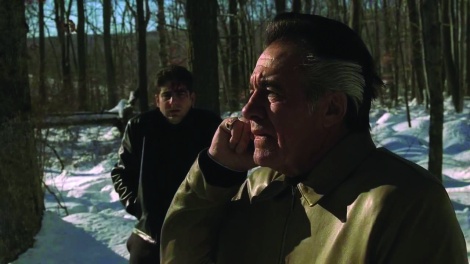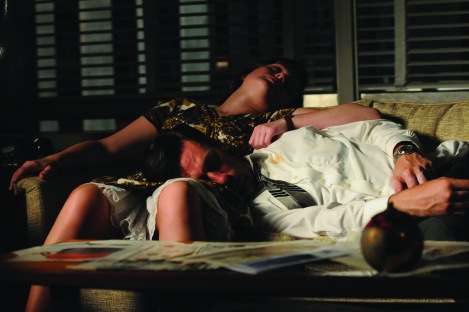Ari Karpel is an AwardsLine contributor. This story appeared in the June 19 issue of AwardsLine.
The first four episodes of Season 2 were pretty much business as usual on HBO’s Girls. Hannah (series creator Lena Dunham) kicked her roommate out after she discovered he slept with her best friend; then she procured coke and had sex with her neighbor as research for an article she had been assigned to write.
That’s when something unexpected happened. In the fifth episode of the love-it-or-hate-it series’ second season, Hannah went down the proverbial rabbit hole.
After a brief scene at the Brooklyn café where Hannah works, the rest of the episode tracked her with a brand-new character, handsome doctor Joshua (Patrick Wilson), playing out a relationship of sorts in his beautifully appointed brownstone. There was topless Ping-Pong, sex in the kitchen and, by the end of the half hour—which took place over two days—an emotional awakening unlike any Hannah had previously experienced. “I don’t think I realized before I met you that I was lonely,” she confesses to Joshua, who turns out to have no interest in her inner life. We never see Joshua again.
“That’s the first hard thing for her that’s leading to the OCD,” showrunner Jennifer Konner explains, referring to the dramatic obsessive-compulsive disorder symptoms that Hannah would manifest later in the season. “We looked at this episode as the rampup.”
And yet even Konner admits that “One Man’s Trash,” as the episode is titled, wasn’t part of the original plan for the season. “Lena wrote it two nights before the table read, like in a fever dream,” says the executive producer. “She came to us with it and said, ‘I don’t know what this is, but I wrote this.’ It was such an insane little movie, we had to make it.”
Girls is not the first serialized TV show to take breaks from its ongoing storyline for filmlike vignettes that upend the usual episode structure, but it employs the technique more often than most. Two episodes later, viewers found themselves far from Hannah’s Brooklyn stomping ground, at the upstate New York home of Jessa’s (Jemima Kirke) parents. “It’s a cliché to say about HBO, but they give you an unbelievable freedom to do what you want to do,” says Konner, who acknowledges HBO’s recently canceled Enlightened as another series that uses so-called standalone episodes to great effect.

The practice arguably goes back to Star Trek, and it was used quite a bit in such 1990’s sci-fi/fantasy series as Deep Space Nine and The X-Files, and continued with Lost and Dr. Who. But TV writers single out one series, also on HBO, for inspiring the spread of standalone episodes across the contemporary TV landscape: The Sopranos. “David Chase took it to such a masterful level,” says Konner. “In the writers’ room, it’s become shorthand. (Executive producer Judd Apatow) will say, ‘The Russian in the woods!’, and we’ll know what he means.”
She’s talking about the “Pine Barrens” episode of Sopranos’ third season, in which Christopher (Michael Imperioli) and Paulie (Tony Sirico) get lost in the woods chasing a Russian mobster they’re trying to kill. (It has also been acknowledged as inspiration for the carjacking-kidnapping episode of Six Feet Under, titled “That’s My Dog.”)
But a funny thing happened when Sopranos creator David Chase rewatched the 2001 episode before speaking with AwardsLine about it: He discovered that it isn’t actually a standalone storyline. “There was a B story and a C story,” reports Chase. “People think of it as standalone because that part of the story is so memorable, and the writing (by Terence Winter, with a story credit by Timothy Van Patten) and acting are so good. What I take from that is they forgot the other stuff. I created the show, and I had forgotten the story about Jackie Jr.”
Nonetheless, when Chase conceived The Sopranos, he wanted it to feel like a series of short films. Looking back, he believes he achieved that best in “College.” The fifth episode of the series’ run has Tony Soprano (James Gandolfini) taking his daughter, Meadow (Jamie-Lynn Sigler), to visit schools in New England, where he spots a former mobster who has been in witness protection. Back home, Carmela (Edie Falco) receives a surprise visit from her priest. “You have all the information you need going in. It doesn’t refer to the episode before it, or after. It stands on its own.”
Chase thinks it’s wise of showrunners to submit such episodes for Emmy consideration. Like series pilots, which dominate the writing and directing categories, these episodes play well with voters who might not have seen the whole season. (Indeed, “College” earned Chase and James Manos, Jr. an Emmy for outstanding writing.)

The Sopranos creator has been particularly impressed by standalone episode work done on shows created by two Sopranos veterans: Matthew Weiner (“The Suitcase” is arguably the best episode of Mad Men, standalone or not); and Terence Winter (Boardwalk Empire delved into incest in “Under God’s Power She Flourishes”). “It’s like a vacation,” Chase explains. “You go away for a week, even for work, and you come back feeling like you’ve learned something.”
In Season 2, “Higher Power” was done from the point of view of Levi (Luke Wilson) at rehab in Hawaii, and “No Doubt” from the POV of White’s own character, Tyler. Those episodes even had those characters’ voiceovers. “I think it helps clarify that character,” says White. “You really get into their inner psychology, and that’s something harder to do in dialogue. With the voiceover you could get into the internal mind of a character, especially mine, who was more of an introvert.”
Had the series continued, White could imagine using a standalone as a jumping off point for a whole new series, in much the way that episodes of Happy Days spawned Laverne & Shirley, Mork & Mindy and Joanie Loves Chachi. “It’s like we created a whole new pilot in Hawaii,” says White. “There was a whole new cast, new sets, different locations. It was fun.”
The standalone episode phenomenon is not exclusive to shows on HBO. NBC’s Community is more like a traditional comedy, meaning its storylines mostly stand on their own. But as often as possible, its fourth-season showrunners, Moses Port and David Guarascio, have followed the tradition established by creator Dan Harmon of doing ambitious episodes that break the show’s rules. In the current season, that meant doing one episode acted out by puppets.
There is one rule that must be followed by all showrunners doing standalone episodes, says Moses, “There has to be a reason why you’re telling your story.” In the case of the puppet episode (“Intro to Felt Surrogacy”), he explains that the school’s dean was using puppet therapy to resolve tensions among the group. “As silly as that might sound, it gives you a reason for going far afield.”
Sometimes the reason is not made explicit to viewers. The Girls episode with Jessa’s parents was inspired by a very real-life need. “We decided to do it because we had to get rid of her,” Konner says bluntly. “Jemima was pregnant, so that episode was going to be her leaving.”
In typical Girls fashion, Jessa’s departure was fairly obscure, signaled by a note on the counter. Hannah headed back to the city on her own. Jessa hasn’t been seen in an episode of Girls since.


I thought that the fifth episode of Girls from the 2nd season was stupid. Not only is Hannah not really a strong enough character on her own to carry an episode but it is the fact that the episode was just so unrealistic. In real life honestly do you see a guy like that finding a girl like Hannah at all good looking? The episode was stupid in a poor second season of a show that had a good first season.